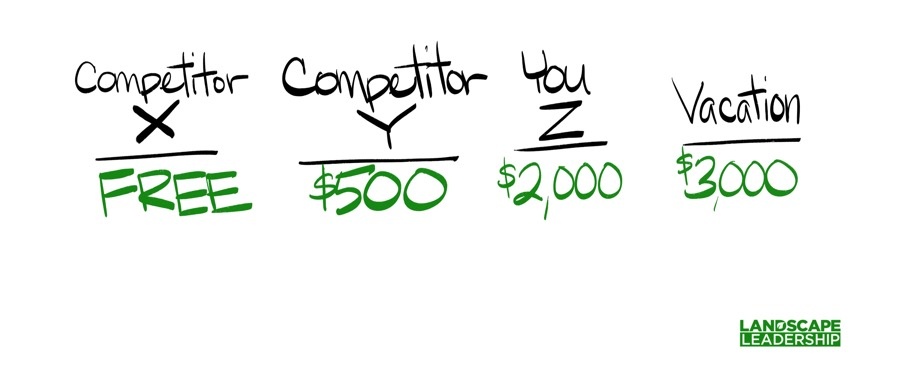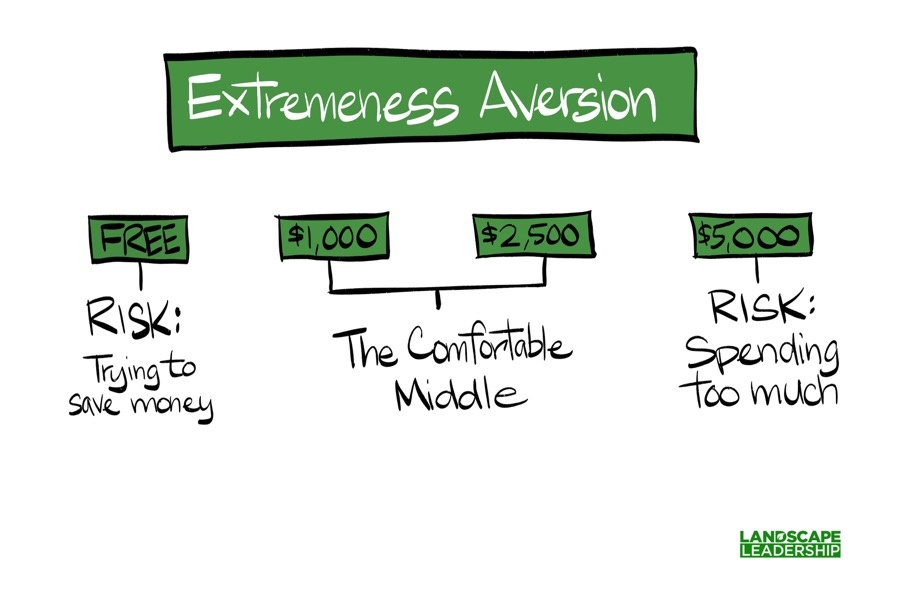How to Bundle Your Landscape Design Services (Including Real Examples)
 Author: Chris Heiler
Author: Chris Heiler
In the previous article I discussed common ways landscaping companies and professional landscape designers charge for landscape design:
- Freebie, foot-in-the-door offer
- Small lump-sum fee (ex- $500)
- Cost-based pricing (time x hourly rate)
Then I proposed the creative way I would price landscape design services if I still had my design firm today:
Price each client and project uniquely by offering three options and prices to choose from.
Creatively bundling your services (and value) this way:
- Improves your closing rates
- Maximizes profitability on each project
- Marginalizes your competitor's offering
- Reduces the amount you over-deliver
Bottom line: Purposeful pricing like this leads to profits from your landscape design work.
Read the first article in this series here.
Crafting your options
When I suggest offering options to your client, I'm referring to bundling your design services into three unique scopes of work, ranging from the most basic offering to the one with the most value.
Offering options like this creates a comparison for your clients that you control.
Without this your client is left to to seek out their own comparisons because they will not understand the value of what you are offering unless they have something to compare it against.

Your client will not only compare you side by side with your competitors but also with whatever else they could buy with their money.
You can win in this scenario – I often did – but why not increase your odds and win more often?
Pricing your options first (i.e.- working backwards)
This point may take you some time to wrap your head around because our industry is so driven by cost-based pricing models:
When crafting your three options, start by determining what three prices you will propose to your client. Only after will you determine what you are willing to offer within each option (deliverables, terms, etc.).
This is why it is so important to price each client and landscape design project uniquely.
Let's look at two examples of this in action.
Example one: The Jacksons
Mr. and Mrs. Jackson recently moved to a nearby neighborhood, purchasing their new home nine months ago. They are ready to renovate their backyard to include a pool and large patio for their family.
They found your company online along with two of your competitors.
You know the following:
- Competitor one offers free landscape design as their foot in the door
- Competitor two charges a flat rate of $500 for their landscape designs
- Mr. and Mrs. Jackson have a budget of between $75,000 and $100,000 for their landscape project
How do you craft your options for the Jackson family?
First, I would offer a low price option between $500 and $1,000 to position against what I know my competitors offer.
I would create a price anchor with my third option, setting it at $5,000 (5% of the $100k budget).
I would then price option two at $2,500 to keep the price a little closer to option one.
Example two: Mrs. Mattingly
Mrs. Mattingly has lived in her home for over 40 years. She has grandchildren now and wants to renovate her home and landscape to accommodate them.
She is familiar with your company and outstanding work and is not interested in talking with multiple contractors.
She has a stated budget of $100,000.
How do you craft your options for Mrs. Mattingly?
First, I would anchor high with option three, pricing it at $10,000 – 10% of the client's total budget.
I would then price option one at $3,000 and option two at $6,000.
I priced these with the intent to sell option two for $6,000.
Notice we haven't talked about what you would actually deliver in each of these options. Start with the price first.
Setting anchor with option three
When I put a $10k option in front of Mrs. Mattingly and present a $5k option to the Jacksons, I'm not holding my breath hoping they'll bite on it.
That high priced option three is only there to make option one and two look affordable in comparison. This is a price anchor.
Always present this high priced third option first and let your client get their brain wrapped around it. All of a sudden option one and two will start looking like a good value in comparison.
When setting your anchor price, ask yourself, "What would I charge for these landscaping plans if my client had unlimited budget and resources?" You could also arrive at your price as a percentage of the total project budget, as I did in the previous two examples. Or use a combination of the two.
Pricing option one and two
A small percentage of clients will purchase your anchor. These are the value buyers and folks who want the best of the best of everything. They want the Tesla with all the options and upgrades.
Option one is for price buyers. The purpose of option one is to communicate what your client does not get. Price this option with your client's budget in mind along with what you know about your competitor's pricing.
This leaves option two in the middle, which is exactly where people are most comfortable.

Extremeness aversion suggests "the attractiveness of an option is enhanced if it is an intermediate option in the choice set and is diminished if it is an extreme option." (Journal of Marketing Research. 1992, Vol. 29, Issue 3, Pages 281-295). There is more risk at the extremes, making the middle a safer option.
Option three exists to make option one and two look affordable. Option one exists to show what your client gives up if they don't choose option two or three.
The goal is to sell option two the majority of the time.
Bundling deliverables and terms
Only after determining the price for each option will you then work backwards and consider what you will deliver in terms of landscape design services.
This is where you can get creative in an effort to push your client towards option two where your high margin should be.
Part of that creativity should involve your terms and conditions, not just your inputs/outputs (ex.- hours, renderings, material lists, etc.). There are many ways you provide value beyond your deliverables. You need to leverage these in your options and pricing as well.
Let's look at how we could bundle options for the Jackson's landscape design proposal. We set the prices for our options at:
Option one: $1,000 | Option two: $2,500 | Option three: $5,000
Before we figure out exactly what we'll offer, we need to determine what cost we are willing to incur in each option.
I know where your brain automatically goes: "Hmm, $2,500 for option two. If I divide $2,500 by $100 which is my hourly design rate, that gives me 25 hours to put into this."
That's the wrong approach, my friends. At least if you're into making money. I'm going to limit myself to 12 to 15 hours if the Jacksons choose option two, so I'll structure the offering accordingly.
Side note: Do you think Mr. and Mrs. Jackson care about how many hours you put into their project? Do you think they care how many hours your competitor puts into their freebie design? Of course not.
Here's one way I could structure the proposal:
|
Option 1 - $1000 Site Analysis 2D Plan View Design
* Payment: 100% in advance * Delivery date: June 15 |
Option 2 - $2500 Site Analysis 2D Plan View Design + Detailed planting plan 3D Computer Rendering
* One round of revisions * Full rights to all intellectual property * Payment: 50% in advance 50% upon completion * Delivery date: June 1 |
Option 3 - $5000 Site Analysis + Survey inc. elevations/topo 2D Plan View Design + Color rendered + Detailed planting plan 3D Computer Rendering Construction Detail Drawings Material Specifications + Plantings + Hardscape materials
* Two rounds of revisions * Full rights to all intellectual property * Payment: 50% in advance 50% upon completion * Delivery date: June 1 |
I structured this to make option two the most attractive. Option three has nearly the exact same terms but more deliverables that the client may or may not care about.
I use option one to show the client exactly what they are giving up if they don't choose option two or three, most importantly no revisions and no rights to the design I create (my intellectual property). I'll also require the $1000 up front and give myself a longer window to complete the design work.
I win with all options. As does my client, because they get to choose which scope and price they are most comfortable with.
Get creative and leverage everything you have to offer!
Wrap up
Purposeful pricing like this in which you control the comparisons will lead to more profitable landscape design work. But why stop there?
This creative pricing principle can be applied to your other service offerings as well, from bundling lawn care services to holiday lighting to large construction projects.
Are you intrigued by this approach to pricing? Schedule a meeting with us to learn how we help lawn and landscape companies develop and implement creative pricing strategies like this as part of our Brand Positioning program.
If you're not ready to talk to us, I suggest subscribing to our blog. You'll get new articles delivered to your inbox every couple of weeks. Subscribe here, or just add your email address in the form below.




